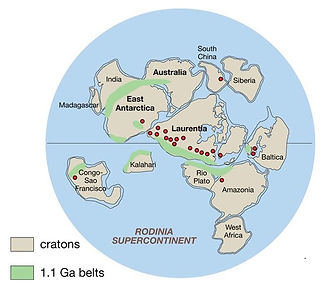Act 1: The Foundations of Avalonia
(1.2-1.0 Billion Years Ago)
The Supercontinent of Rodinia
The differentiation of the crust from the mantle of the earth started early in its history. In addition, a differentiation between denser basaltic oceanic crust and lighter, "granitic" continental crust began early on, although from some time the earth was likely too hot for such differences to be maintained for long on a large scale. Eventually the earth was cool enough for the crust to persist and for these differentiated areas to remain. At this time a network of crustal “plates” that sat atop the mantle. Amongst the denser basaltic plates were small concentrations of granitic crust. These less dense crustal fragments, which sat atop the denser basaltic crust, would form the nucleus of the continents of today. Under the influence of the plate tectonics driven by the heat engine of the deep earth, these continental fragments began to coalesce over time into larger crustal assemblies called cratons. Scientists believe that the original core of North America was formed from seven different smaller microcontinents that were brought together around 1.5 billion years ago. For the last billion years ago, no new cratons have been created. However, the continental plates have continued to move with the ever-shifting oceanic plates and have assembled with and disassembled from other continental plates. Plate tectonics pushes continents together and then separates them an ongoing "dance of the continents." You can see a rapid visualization of three billion years of the dance of the continents here.
At several points over the last 4.5 billion years of earth's history, continental drift has brought continents together into larger “supercontinents” or, in a few cases, combined most or all of these into a single supercontinent. One of the interesting recent insights from plate tectonic theory is called the supercontinent cycle: the concept that over a periodicity of around 500 million years, continental plates tend to come together into a unified whole, disperse, then re-assemble. There are three times when most geologists agree that all the continental plates were assembled together: at about 1.8 Ga (Columbia), 1.2 Ga (Rodinia), and 270 Ma (Pangea). There is less consensus on the supercontinents that may have formed before Columbia and the identification of a supercontinent called Pannotia at about 600 Ma is controversial. There is no doubt that the phase where continental plates are moving apart and when they are converging is marked by distinct geologic characteristics (Nance and Murphy 2018). The last (and best documented) supercontinent, Pangea, broke up about about 175 million years ago and we are currently in a time when continents are highly dispersed; it is likely that in the far future--another 250 million years or so--another supercontinent may form (See projections about Pangea Proxima).
The Foundations of Avalonia
The foundations or “basement rock” of Avalonia may have been generated about 1.0-1.2 Ga during the assembly of the supercontinent Rodinia. Rodinia is Russian for “homeland.” The single large landmass was surrounded by a global ocean called “Mirovia.” In areas where some of the large continental plates came together, the collisions formed large mountain chains. Geologists refer to this mountain-building phase as the Grenville orogeny (orogeny means “mountain formation”). You can see the “roots” of some these mountains in exposures in parts of upper eastern New York, which at that time was located on the margin of a continental plate called Laurentia, which makes up a major portion of what is now North America, including Greenland. A reconstruction of Rodinia is shown on the right. You can see the Grenville mountain belts in green
While the plates that made up Rodinia were locked together at this time, there were still areas in the ocean where oceanic plates were meeting and subduction was occurring. One instance of this was hypothesized to have occurred somewhere off the southeastern coast of Rodinia (the area offshore of Baltica-Amazonia-W. Africa) near the south pole. The subduction of one plate under the other created an island arc, where active magmatic activity fed volcanoes and built up the crust above sea level. There are no examples of basement rock have been identified within the Avalonian terrane from this period of time (the Westboro formation, a quartzite deposit north of Boston, has been dated to 800-900 Ma and may represent a metamophosed sandstone eroded from this ancient terrane), so the true origin of the foundation of Avalonia is uncertain. Indirect evidence for this hypothesis includes the isotopic fingerprints and radiometric data of minerals found in later intrusions, particularly zircons. The older zircons found in Avalonian rocks are dated to about 1.0 to 1.2 billion years old and their isotopic fingerprint suggests derivation from subduction-generated island arc deposits (Murphy et al. 2000). A modern example of such an island arc system is the Aleutian island chain off the west coast of Alaska. A recent study (Henderson et al. 2016) suggests that isotopic age distributions of the older zircons found in Avalonian sedimentary rocks have a greater affinity with Baltica; these authors posited that Avalonia may have formed as a New Zealand-like “ribbon-continent” that detached from Baltica and accreted to Amazonia by ~670 Ma. In the future, new research may clarify the “parentage” of the basement upon which Avalonia was built.
Figure at right shows the area of potential development of an oceanic island arc built up from juvenile crust off the southeast coast of Rodinia (dotted area). The orogenies from the earlier assembly of Rodinia also shown (wavy lines). The direction of motion of the cratons that made up Rodinia are shown with larger arrows. Source: Murphy et al. 2000.


Image from John Goodge